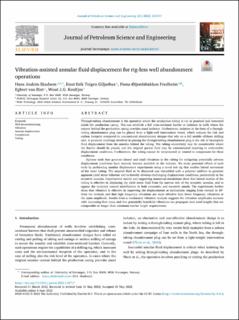| dc.contributor.author | Skadsem, Hans Joakim | |
| dc.contributor.author | Giljarhus, Knut Erik Teigen | |
| dc.contributor.author | Øijordsbakken Fredheim, Fiona | |
| dc.contributor.author | van Riet, Egbert | |
| dc.contributor.author | Keultjes, Wout J. G. | |
| dc.date.accessioned | 2022-06-27T06:53:48Z | |
| dc.date.available | 2022-06-27T06:53:48Z | |
| dc.date.created | 2022-06-06T22:03:10Z | |
| dc.date.issued | 2022 | |
| dc.identifier.issn | 0920-4105 | |
| dc.identifier.uri | https://hdl.handle.net/11250/3000946 | |
| dc.description.abstract | Through-tubing abandonment is the operation where the production tubing is cut or punched and cemented inside the production casing. This can establish a full cross-sectional barrier or isolation in wells where the cement behind the production casing provides zonal isolation. Furthermore, isolation in the form of a through-tubing abandonment plug can be placed from a light-well intervention vessel, which reduces the risk and carbon footprint compared to conventional abandonment designs that rely on a full mobile offshore drilling unit. A potential challenge involved in placing the through-tubing abandonment plug is the risk of incomplete fluid displacement from the annulus behind the tubing: The tubing eccentricity may be considerable where the barrier should be placed, and the original packer fluid may be contaminated resulting in unfavorable displacement conditions. Furthermore, the tubing cannot be reciprocated or rotated to compensate for these conditions. Agitator tools that generate lateral and axial vibrations in the tubing for mitigating potentially adverse displacement conditions have recently become available to the industry. We study potential effects of such tools by performing annular displacement experiments using a novel test rig that enables lateral movement of the inner tubing. The original fluid to be displaced was viscosified with a polymer additive to generate apparent yield stress behavior and to thereby develop challenging displacement conditions, particularly in the eccentric annulus. Experimental results and supporting numerical simulations show that lateral motion of the tubing is effective in displacing the yield stress fluid from the narrow side of the eccentric annulus, and to oppose the tendency toward stratification in both concentric and eccentric annuli. The experiments further show that vibration is effective in improving the displacements at inclinations ranging from vertical to 80° from the vertical, and that high frequency vibrations are more effective than lower frequency vibrations at the same amplitude. Results from a mechanical vibration analysis suggests the vibration amplitudes increase with increasing flow rates, and that potentially beneficial vibrations can propagate over axial lengths that are comparable or longer than minimum barrier length requirements. | en_US |
| dc.description.abstract | Vibration-assisted annular fluid displacement for rig-less well abandonment operations | en_US |
| dc.language.iso | eng | en_US |
| dc.rights | Navngivelse 4.0 Internasjonal | * |
| dc.rights.uri | http://creativecommons.org/licenses/by/4.0/deed.no | * |
| dc.title | Vibration-assisted annular fluid displacement for rig-less well abandonment operations | en_US |
| dc.title.alternative | Vibration-assisted annular fluid displacement for rig-less well abandonment operations | en_US |
| dc.type | Journal article | en_US |
| dc.type | Peer reviewed | en_US |
| dc.rights.holder | © 2022 The Author(s) | en_US |
| dc.description.version | publishedVersion | en_US |
| cristin.ispublished | true | |
| cristin.fulltext | original | |
| cristin.qualitycode | 2 | |
| dc.identifier.doi | 10.1016/j.petrol.2022.110717 | |
| dc.identifier.cristin | 2029693 | |
| dc.source.journal | Journal of Petroleum Science and Engineering | en_US |

